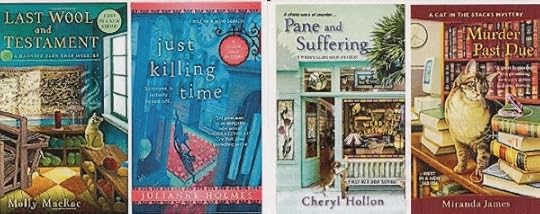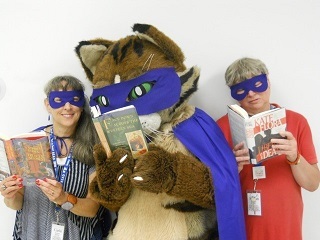Lea Wait's Blog, page 260
May 23, 2016
Going to the Source of Inspiration
In Cover Story, the second book in the Joe Gale series, my newspaper reporter protagonist finds himself on deadline without a computer. Does Joe panic? Nope. He goes to the local library.
He’s covering a high-profile murder trial in Machias during the brutal winter of 2015. His laptop is stolen when he’s on deadline in an apparent attempt to stop him from writing about unexpected testimony and contradictory evidence. Nothing if not resourceful, Joe responds by walking across Court Street to Porter Memorial Library where a helpful librarian and public access computers save the day.

Beautiful, historic Porter Memorial Library in Machias
When a writer features an actual library in one of her books, it goes without saying she must do a reading there. That’s why I was tweeting and facebooking from Porter Memorial Library a couple of weeks ago, the little gem of a library that played a small but critical role in Cover Story.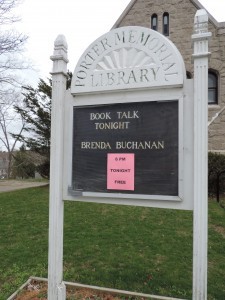
Here’s one of the passages about Joe Gale’s use of the library:
Earlier in the week I’d noticed the Porter Memorial Library—a handsome granite structure that looked almost like a small church—across from the front door of the courthouse. As luck would have it, the librarian was not the sort to close the library’s doors at the sight of a few flakes of snow. Five feet tall with gray hair hanging loose to her waist, she peered at me through granny glasses when I asked about internet access. She said the library had Wi-Fi so I could work from any seat in the house. I found a quiet corner, reviewed my notes and began to write.
Ninety minutes later I scrolled through my story, frustrated by the undeniable fact that it didn’t sing. In fact, it didn’t even hum. I hadn’t eaten lunch yet, and my mind kept shooting back to the events of the previous night. The result was an awkward lead and a disjointed narrative. I went to the john, washed my face, returned to my seat and tried again.
**
My Machias reading originally was scheduled for mid-December but an unexpected snowstorm caused the event to be rescheduled for May 4, when spring was beginning to make itself known Downeast.

Library Director Lee Downing
I was delighted beyond words to read at Porter Memorial, where director Lee Downing and an enthusiastic bunch of readers welcomed me. I’d visited incognito when I was writing Cover Story to make sure I had the feel of the space. At the time, I wasn’t imagining a future reading there. But once the book was published, arranging a visit to Porter Memorial Library was high on my must-do list.
I explained to the folks who attended my reading that Cover Story actually is the first book I actually wrote−though not the first to be published−and for that reason it will forever hold a special place in my heart, as will Machias, its courthouse and its library.
Cover Story is a book about a trial, minus the boring stuff that happens in real life trials and featuring several harrowing scenes that were easy to imagine happening in the tundral landscape of Downeast Maine in January.

They gave me the best seat in the house
When writing the book I worried about getting Washington County wrong. I’d lived in neighboring Hancock County but never all the way Downeast, which is very much its own place. I know the geography well enough (and I have a trusty DeLorme) but writing about a distinctive community requires an understanding of the people who live there and respect for regional culture.
I made a couple of trips to Machias during the writing process−an especially memorable one on a cold weekend in February−to remind myself about the cadence of life in Washington County and the intensity of the wind howling across the blueberry barrens. I hope I did that wild and beautiful county justice.
MCW emerita Sarah Graves−who lives and writes in Eastport−reassured me with a generous blurb about Cover Story [3] and nobody showed up at the May 4 reading to argue otherwise.
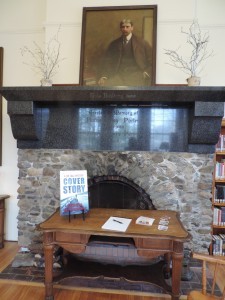
The fireplace still warms the reading room on winter days
The evening was a total pleasure. It took place in the handsome reading room where a comfortable wing chair had been arranged for me next to a gorgeous stone working (!) fireplace.
Old friends and new were there, enthusiastic and full of good questions.
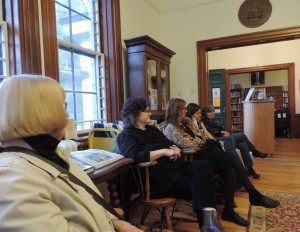
Some of the folks who came to Porter Memorial to hear me read from COVER STORY
I read a couple of passages, making a point to end with this line from the book: “You know what they say about Downeast Maine. The only thing more rugged than the coastline is the women.”
Laughter told me the audience appreciated the compliment.
Who neither wears granny glasses nor has hair that hangs to her waist.
I was worried about pretty much everything, to be honest. It was my first book.
Sarah, bless her, said this: COVER STORY gets Downeast Maine right, from its hard-headed, warm-hearted inhabitants to its remote, tragic beauty, and in it Brenda Buchanan spins a devious, deeply-felt tale as dark as a Maine winter. Add a smart, seasoned journalist-hero Joe Gale and Buchanan’s own intensely readable prose and you’ve got another you’re-gonna-love-it winning entry in an excellent series.
Brenda Buchanan’s Joe Gale Mystery Series features an old-school reporter with modern media savvy who covers the Maine crime beat. Cover Story may have been the first written, but it’s the second in the series. The first is Quick Pivot and the most recent is Truth Beat. All are available in digital format wherever fine ebooks are sold
Brenda can be found on the web at www.brendabuchananwrites.com on Twitter at @buchananbrenda and on Facebook at Facebook.com/BrendaBuchananAuthor.
May 22, 2016
Back to the Old Home Town: Why is this plot device used so often?
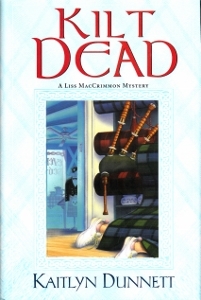 Kaitlyn Dunnett/Kathy Lynn Emerson here, today blogging about a topic that came up in the Q&A session after a panel I was part of not too long ago. The gist of the question was: why do so many cozy series (and not just cozies) begin with the sleuth returning to her old home town after X number of years away? Unspoken may have been another question: why do you writers keep using this tired old device?
Kaitlyn Dunnett/Kathy Lynn Emerson here, today blogging about a topic that came up in the Q&A session after a panel I was part of not too long ago. The gist of the question was: why do so many cozy series (and not just cozies) begin with the sleuth returning to her old home town after X number of years away? Unspoken may have been another question: why do you writers keep using this tired old device?
Well, yes, I have to admit that many of us have begun book one in a series with this particular set up, but there is a good reason for it. In fact, if you look at most mysteries—heck, look at most novels!—there are only three choices a writer has about the setting in relation to the protagonist. One is that the character is a long-time resident who already knows a great deal about the other characters. Miss Marple comes to mind. The second is that he or she is a newcomer to the area and therefore experiences people and places for the first time and brings an outsider’s perspective and a fresh point of view to the story (and to solving the crime). The third choice is to use a protagonist who has returned to a place she once knew well. To my mind, choice #3 has huge advantages over the other two because this situation combines the best parts of both of them. The sleuth has a certain degree of familiarity with people and places and is not dealing only with total strangers. At the same time, things have changed while she was elsewhere and she will need to rely on one or more of the characters who stayed behind to help put the pieces of the puzzle together.
 I would argue that this plot device can’t be overused simply because there are so many variations. The reason she comes back is probably the biggest one. In my Liss MacCrimmon series, it is because Liss has suffered a career-ending knee injury and needs a place to recover and decide what she’s going to do next. She was a professional Scottish dancer. In the first book in the series, Kilt Dead, she fills in for her aunt by running the family business, Moosetookalook Scottish Emporium. For Barb Ross’s sleuth, Julia Snowden, in the Maine Clambake Mysteries, it is a family financial crisis that brings her back to Busman’s Harbor, Maine, while in Lea Wait’s Mainely Needlepoint Mysteries, Angie Curtis returns to Maine in response to a phone call from her grandmother telling her that her mother, who disappeared many years before, has been found. That is also the murder Angie must solve.
I would argue that this plot device can’t be overused simply because there are so many variations. The reason she comes back is probably the biggest one. In my Liss MacCrimmon series, it is because Liss has suffered a career-ending knee injury and needs a place to recover and decide what she’s going to do next. She was a professional Scottish dancer. In the first book in the series, Kilt Dead, she fills in for her aunt by running the family business, Moosetookalook Scottish Emporium. For Barb Ross’s sleuth, Julia Snowden, in the Maine Clambake Mysteries, it is a family financial crisis that brings her back to Busman’s Harbor, Maine, while in Lea Wait’s Mainely Needlepoint Mysteries, Angie Curtis returns to Maine in response to a phone call from her grandmother telling her that her mother, who disappeared many years before, has been found. That is also the murder Angie must solve.
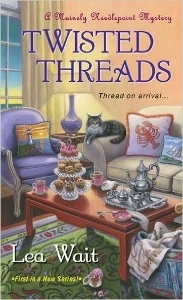 The death of a parent or grandparent and/or an inheritance to be dealt with is what brings many protagonists back home (or at least to a place where they spent part of their childhood). In Molly MacRae’s Haunted Yarn Shop Mysteries, Kath Rutledge receives a twofold inheritance from her grandmother—the yarn shop and the onset of hereditary psychic abilities. The first of Julianne Holmes’s Clock Shop Mysteries sends a grieving Ruth Clagan to deal with her grandfather’s business in a town where she spent many of her summers. The debut of Cheryl Hollon’s Webb’s Glass Shop Mysteries has Savannah Webb taking over the family stained glass business. On the surface, these set-ups sound similar, but they contain a great deal of variety, and not just in the type of store their protagonists inherit.
The death of a parent or grandparent and/or an inheritance to be dealt with is what brings many protagonists back home (or at least to a place where they spent part of their childhood). In Molly MacRae’s Haunted Yarn Shop Mysteries, Kath Rutledge receives a twofold inheritance from her grandmother—the yarn shop and the onset of hereditary psychic abilities. The first of Julianne Holmes’s Clock Shop Mysteries sends a grieving Ruth Clagan to deal with her grandfather’s business in a town where she spent many of her summers. The debut of Cheryl Hollon’s Webb’s Glass Shop Mysteries has Savannah Webb taking over the family stained glass business. On the surface, these set-ups sound similar, but they contain a great deal of variety, and not just in the type of store their protagonists inherit.
The character of the home town varies as widely as the emotional baggage the sleuth brings with her when she returns to a once familiar place. Coastal Maine and the Western Maine mountains are different worlds. Blue Plum, Tennessee is not Orchard, Massachusetts. Nor is it Athena, Mississippi, the setting for two series by the prolific Miranda (aka Dean) James. In the Cat in the Stacks Mysteries, Charlie Harris, a librarian, has returned to Athena after inheriting a house from his aunt.
When I started work on an idea for a new series, it never occurred to me that I was repeating myself by having the new sleuth return to her old home town. In fact, going back is kind of the point of the book. Mikki Lincoln is a woman my age (sixty-eight) who moved away right after high school. It’s an invitation to her fiftieth high school reunion that gets her thinking about her old stomping ground. A recent widow, she sells her home in Maine and heads for the rural New York state community where she grew up. In fifty years, there have definitely been changes. She’s in familiar territory . . . and yet she’s not. For an amateur sleuth, that seems to me to be the best of all possible worlds.
Kathy Lynn Emerson/Kaitlyn Dunnett is the author of over fifty books written under several names. She won the Agatha Award for best mystery nonfiction of 2008 for How to Write Killer Historical Mysteries and was an Agatha Award finalist in 2015 in the best mystery short story category for “The Blessing Witch.” Currently she writes the contemporary Liss MacCrimmon Mysteries (Kilt at the Highland Games ~ July 2016) as Kaitlyn and the historical Mistress Jaffrey Mysteries (Murder in the Merchant’s Hall) as Kathy. The latter series is a spin-off from her earlier “Face Down” series and is set in Elizabethan England. Her websites are www.KaitlynDunnett.com and www.KathyLynnEmerson.com
May 20, 2016
Weekend Update: May 21-22, 2016
 Next week at Maine Crime Writers there will be posts by Kaitlyn Dunnett/Kathy Lynn Emerson (Monday), Brenda Buchanan (Tuesday), Kate Flora (Wednesday), Vaughan Hardacker (Thursday), and Jen Blood (Friday).
Next week at Maine Crime Writers there will be posts by Kaitlyn Dunnett/Kathy Lynn Emerson (Monday), Brenda Buchanan (Tuesday), Kate Flora (Wednesday), Vaughan Hardacker (Thursday), and Jen Blood (Friday).
In the news department, here’s what’s happening with some of us who blog regularly at Maine Crime Writers:
Libraries who enter Sisters in Crime’s We Love Library lottery have to submit a photo of staff holding three books by SinC authors. The April winner was the New Gloucester Public Library here in Maine and they chose books by Kaitlyn Dunnett, Kathy Lynn Emerson, and Kate Flora. Congrats to the library, which will be receiving a check with which to buy books. And here’s the picture they submitted:
In other Maine news, bestselling mystery writer Nevada Barr has set her newest Anna Pigeon novel, Boar Island, in Acadia National Park. If you’d like to meet her, she will be making two appearances at Maine libraries. On Monday, May 23 at 6:30 PM she will be at Jesup Memorial Library in Bar Harbor and on Tuesday, May 24 at 6:30 PM she will be the guest of Gray Public Library in Gray, Maine. The Gray event will be held at the Spring Meadow Golf Club. Tickets are free, but must be acquired in advance. For more information, call 657-4110.
From Kaitlyn Dunnett: I’ve just added a special Scottie page to my Kaitlyn Dunnett website, for those who are interested in reading more about the two Scottish Terriers, Dandy and Dondi, who appear in The Scottie Barked at Midnight and will reappear, although only briefly, in Kilt at the Highland Games. You can find it at Kaitlyn’s Scottie Page Enjoy!
An invitation to readers of this blog: Do you have news relating to Maine, Crime, or Writing? We’d love to hear from you. Just comment below to share.
Keep those comments coming. Another bag of books and Maine goodies will go to one lucky person who reads and reacts to our blog posts.
And a reminder: If your library, school, or organization is looking for a speaker, we are often available to talk about the writing process, research, where we get our ideas, and other mysteries of the business. Contact Kate Flora: mailto: kateflora@gmail.com
May 18, 2016
Word of Inspiration – for Writers and Others
Twenty-five years ago I wasn’t a published writer living in Maine. I was a corporate manager living in New Jersey, vacationing in Maine, caring for four teenaged daughters, one granddaughter, my mother, and, at work, the up to 125 people reporting to me. The teenagers were troubled, my mother and granddaughter were disabled, and my corporate family was challenged by reorganizations, downsizing, and internal politics.
I wanted desperately to get out of corporate life, move to Maine, and write something other than corporate reports. I started journaling, writing short stories, studying the world of publishing, and trying to convince myself my future would be brighter.
One of the things I did was write down quotations I ran across in my reading; quotations that I felt either spoke to writing or to my life. I kept them in a bound blank book, which I carried everywhere for hope and encouragement.
A few days ago I picked up that book, still next to my dictionary and thesaurus on my desk, and browsed through it. In case any of the rest of you are also looking for words to think about, here are a few of the quotations I recorded.
“Clara says the truth is that I don’t want anything because there’s nothing I want that I believe I can have, when in fact all I have to do is reach out my hand. She really gets on my nerves sometimes.” — Marilyn French, Her Mother’s Daughter
“Nobody made a greater mistake than he who did nothing because he could only do a little.” — Edmund Burke
“There was, even at seventy, no escape. One did one’s work against a steady barrage of demands of people .. and the garden, too! It was all very well to insist that art was art and had no sex, but the fact was that the days of men were not in the same way fragmented, atomized by indefinite small tasks.” — May Sarton, Mrs. Stevens Hears the Mermaids
“If at first you don’t succeed, you are running about average.” – M.H. Anderson
“The most serious charge which can be brought against New England is not Puritanism, but February.” – Joseph Wood Krutch
“What lies behind us and what lies ahead of us is of little importance compared to what lies within us.” – Oliver Wendell Holmes
“My advice to the women of America is to raised more hell and fewer dahlias. – William Allen White
“It is more important to live the life one wishes to live, and to go down with it if necessary, quite contentedly, than to live more profitably but less happily.,” – Marjorie Kinnan Rawlings.
“We tend to be much kinder to other people – our friends, relatives, and offspring – than we are to ourselves.” – On Writers’ Block
“A writer is not so much someone who has something to say as he is someone who has found a process that will bring about new things he would not have thought of if he had not started to say them.” – William Stafford
“perhaps his life (Walt Whitman’s) had to be partial in order for his work to be whole.” – Justin Kaplan, Walt Whitman
“We judge ourselves by what we feel capable of doing, but others judge us by what we have already done.” – Henry Wadsworth Longfellow
Now, twenty-five years or so after I recorded those quotations, I’ve moved to Maine, my children have grown up and produced eight children of their own, my mother has died, I’ve married the man I ‘d loved for most of my adult life, but who was not in my life in those dark days twenty-five years ago, and I’ve had 17 books published, with two more scheduled for the fall of this year.
My life is what I’d hoped for, and worked toward. But sometimes there are still difficult days. And sometimes the right words can help me onward.
Perhaps today one of these quotations will speak to you.
Maine author Lea Wait writes the Mainely Needlepoint mystery series and the Shadows Antique Print mystery series and historical novels for ages 8 and up set in nineteenth century Maine. She invites readers to friend her on Facebook and Goodreads and check her website, http://www.leawait.com for more about her life and her books.
Mystery writers: truly a community, and the best kind
OK, Maine Crime Writers fans, the mystery of the missing blog post has been solved. Because here it is. Sorry it’s a little late today. OK, a lot late.
But you know what I DID do today? I signed up for the New England Crime Bake. For those of you who don’t know what that is, it’s held in Dedham, Massachusetts, every year on Veterans Day weekend. A conference for mystery writers and fans. And it’s awesome.
I’m probably repeating myself, because I know I’ve blogged about Crime Bake before, but everything about it bears repeating.
I went to my first one in 2008, desperate to find a way to get going on the mystery novel I’d planned on writing my entire life. I’ve gone every year since, and when I hit it this year, I’ll have two published mystery novels under my belt. I owe a lot of that to Crime Bake.
Not only was listening to the writers, publishers, editors — everyone at the conference — motivating, but it was also a huge learning experience for someone who knew next to nothing about getting a mystery novel published. Or, obviously, even getting one written.
Just as important, I made friends there that have been the foundation of my mystery writing career. At my first one, I met June Lemen and Lisa Haselton, two other New Hampshire writers, and we formed a writing group. That got me writing Cold Hard News, my first Bernie O’Dea mystery.
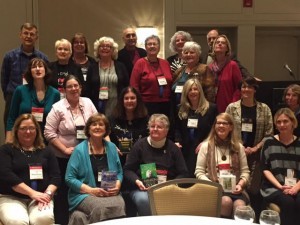
That’s me, second row second from left, in pink, with the other 2015 debut novelists at last year’s Crime Bake. Brenda Buchanan is two to my left, in the red sweater.
Over subsequent years I met fellow Maine Crime Writers blogger Brenda Buchanan, who, it turns out, was the reporter who always beat me when she was with the York County Coast Star and I was with the Biddeford Journal-Tribune in the early 1980s.
There are a lot of other people, too. Some of them I just see once a year (and on Facebook, of course), but it always feels like it was just yesterday.
I’ll tell you something about the newspaper business you may never guess otherwise: it’s not the most nurturing, supportive environment. It’s stressful, the stakes are high, our mistakes are out there for the world to see. People don’t send us flowers (OK, it happened to me once, but the guy was kind of a stalker), and rarely call or email to tell us they love us or what we do. They do call, but not to tell us that.

Doin’ journalism.
Even the hardest, most satisfying work is there for a flash, a day or two, then gone. I’m not bashing it. I’ve been doing daily journalism for thirty-three years and I love it. It’s a vocation to me, not just a career, and I can’t imagine doing anything else (or imagine anyone else who would have me).
The only other thing I could imagine doing is being a full-time mystery writer. And one of the things that would make that so awesome, aside from all the other obvious things, is the mystery writing community. I was welcomed when I was struggling to write a novel, I was welcomed as I was writing it, and I was welcomed after I was published. I’ve never, ever heard a harsh word from a fellow mystery writer, never felt like what I was doing wasn’t worthwhile or I wasn’t a member of the club. The encouragement and support is phenomenal.
Aside from the really good advice, support and encouragement from my former writing group and Brenda, and countless other friends in the mystery writing community, here’s stuff that wouldn’t have happened to me without Crime Bake:
When Cold Hard News was “finished,” but I still didn’t have a publisher, I signed up for a manuscript critique at the 2014 Crime Bake. I don’t get easily discouraged, but I’d been pitching and revising for four and a half years and if I weren’t a stubborn blockhead, may have given up. Hank Phillippi Ryan was my critiquer (I don’t want to say critic). She went through my first chapter with me in such a thorough and insightful way that Friday night that I spent the next afternoon rewriting it. When I told her Saturday night that I was inspired and reworking it, she encouraged me to email it to her when I was done. Right, I thought. She’s a nice person, but very busy and I doubt she has time for my cruddy manuscript. Sunday, after I got home from Crime Bake, I sent the reworked chapter to her anyway. She responded a couple hours later with an ecstatic email telling me what a great job I’d done, including an all-caps WOW and an admission that it made her teary-eyed.
Two months later, after I decided to skip trying the whole agent thing and directly query publishers who accepted submissions from authors, my now-publisher liked my manuscript. Maybe it would have happened anyway, but if they can’t get through the first chapter, they won’t read the rest. I have Hank to thank for that.
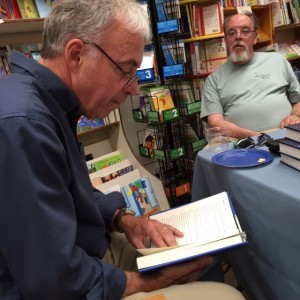
Gerry Boyle reads from Once Burned at a dual book signing in Waterville, Maine, last June.
After Cold Hard News came out, Ellen Richmond, a bookseller in Waterville, Maine, agreed to a signing with me and fellow Maine Crime Writer Gerry Boyle. Now you have to understand how Gerry is regarded in Maine. I work for the same newspaper he once did, and when people found out I was writing a mystery novel, they’d say “Like Gerry Boyle?” or “Have you heard of Gerry Boyle?” or “Now Gerry Boyle, there’s a mystery writer.” I don’t disagree. In fact, when I read his first book, Deadline, in the early 1990s, it was the first mystery I ever read that I felt got journalism right. He got Maine right, too. And I said, “See? I want to do what that guy does.” So yeah, I knew who Gerry Boyle was.
At a Crime Bake before Cold Hard News was published, I approached Gerry after he did a master class on writing character. I was kind of shy, thinking the big-shot writer would brush me off, but I wanted to introduce myself now that I was back in Maine and worked where he used to. Not only didn’t he brush me off, he was friendly and gracious enough that it led to a friendship.
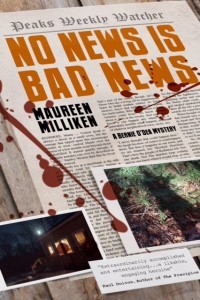
No News is Bad News, the second in the Bernie O’Dea mystery series, coming out in July. Thanks, Crime Bake!
That said, I was still nervous about a dual book signing last June. Here I was with my one book, shaky as hell that no one would like it, and Gerry was promoting Once Burned, his zillionth or gazillionth I think (the gazillionth-and-one just came out this week: Straw Man). Lots of people came to the signing, most of them to see Gerry. But here’s what Gerry did: he talked up my book. He didn’t have to, but he did. More than his own, or at least that’s how it felt. And people bought it.
Both of those experiences were huge lessons to me well worth the price of the Crime Bake admission. What they brought me in terms of “success” aren’t even the most important things about them.
Writing a mystery? Or even a non-mystery? Consider going to Crime Bake this year. You won’t regret it.
Maureen Milliken is the author of the Bernie O’Dea mystery series. Cold Hard News was published in June 2015, and No News is Bad News is due out in July. She is City Editor of the Morning Sentinel newspaper in Waterville, Maine. Follow her on Twitter @mmilliken47, on Facebook at Maureen Milliken mysteries and sign up for email updates on her website, maureenmilliken.com.
May 17, 2016
Into the Flow
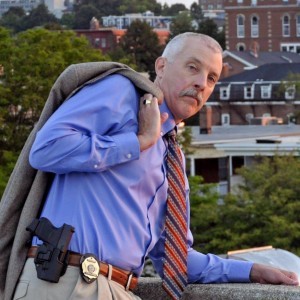 Last October I had the great pleasure of taking part in the first annual Murder by the Book, a two day event held at Bar Harbor’s historic Jesup Memorial Library. Is there anything more inspiring than autumn on the coast of Maine? As a rookie, among a dozen accomplished and award-winning Maine novelists, I was thrilled to have been included. On Friday evening, a handful of writers read aloud from unpublished works, gifting those in attendance a rare treat, a sneak peek at upcoming novels.
Last October I had the great pleasure of taking part in the first annual Murder by the Book, a two day event held at Bar Harbor’s historic Jesup Memorial Library. Is there anything more inspiring than autumn on the coast of Maine? As a rookie, among a dozen accomplished and award-winning Maine novelists, I was thrilled to have been included. On Friday evening, a handful of writers read aloud from unpublished works, gifting those in attendance a rare treat, a sneak peek at upcoming novels.
During one of the Saturday panels, Gerry Boyle and Julia Spencer-Fleming briefly discussed “the flow” that occasionally happens while writing. Being in the zone. Storytelling autopilot. Those times our stories take unexpected turns as they are being written. When characters begin to speak and act for themselves as the writer struggles to keep up. I used to believe this writerly flow was something that famous writers said to sound hip, that is, until it began happening to me. Any writer will tell you, those days are the absolute best, rare though they may be. If we could figure out a way to bottle that flow, manuscripts for entire novels would be completed in mere weeks. Unfortunately, it doesn’t work that way. It happens when it happens, often departing as quickly as it came. Writing a novel is hard work, believe me. Endless hours sitting in a chair, staring at a monitor, trying to untangle thoughts into something comprehensible and entertaining. But still, there are those glorious times when it almost seems to write itself.
As the author panel continued, I began to mentally wonder off, though no fault of Julia or Gerry, pondering this anomaly. I wondered, where does this flow come from? Is it a vehicle by which some magical muse inserts ideas into our heads? Sitting upon our shoulders and whispering suggestions. Or leading our fingers to the correct letters on the keyboard, rendering it into some kind of electronic Ouija board. And why doesn’t it happen to everyone? Why aren’t we all accomplished raconteurs? After all, everyone has a story to tell. Our entire lives are comprised of them. Those things that happen as we traverse the long and bumpy road of life. But if that’s all it takes, if we really are all bursting with stories ready to be told, where is release button to make them flow? Does the muse only appear to some folks and not others? Or could it be something else entirely?
I think it’s far more likely that we writers, who spend an inordinate amount of time inside our own heads, have simply exercised and developed the imagination muscle more than most. We’ve spent so much time poking holes in that thin membrane of the creative mind, the mental fabric restraining our best thoughts, that the stories just flow freely from our mind to the page.
Other writers may disagree. Each of us probably have our own thoughts on the source of this creative wellspring. But whatever the cause, I am sure of one thing. We’d all be eternally grateful if it happened more often.
May 16, 2016
Price Drop
Jessie: In New Hampshire, eagerly awaiting school to let out allowing her return to the coast of Maine.
As a thrifty New Englander I keep a weather eye on prices at the grocer. I have a bunch of kids and have spent a lot of years keeping them fed on a budget that would do my Mainer grandmothers proud. One easy and nutrious trick up my mitten has always been a reliance on recipes featuring eggs. No one looks at a spinach souffle and thinks you’ve offered them a cheap dinner. They are more inclined to ohh and ahh over the delightful smell and the cloud-like texture.
But in the last few months, those staples of my refrigerator have been much more expensive. Those of you who don’t do the shopping in your household may not be aware that the price of eggs has spent time in the scandalous range. At my local grocer a dozen of them reached the high price of $3.00. It was like a sign of the end times!
But this week, when I conducted the shopping, it was with a light heart I noticed a sale sign hanging over the egg display. In celebration of the price returning to 89 cents per dozen I thought I would share one of my favorite egg-based recipes. It is dairy free, gluten freen and delicious. It’s easy to make and perfect for warm weather. I use the leftover egg whites to make meringues.
Pineapple Nutmeg Flan
3 cups pineapple juice
1 cup brown sugar
1/2 teaspoon ground nutmeg
18 large egg yolks
In a saucepan bring pineapple juice adn 1/4 cup of brown sugar to a boil, stirring constantly, until the sugar dissolves. Lower heat to medium and simmer until reduced to about 2 cups. Stir occassionally. This will take about half and hour. Cool to room temperature.
Preheat the oven to 350F.
In a clean saucepan combine 3/4 brown sugar and 3 tablespoons of water. Stir over low heat until the sugar dissolves. Raise heat to high and cook, without stirring, until the sauce reaches a deep caramel color, approximately 10 minutes. You may swirl the pan gently if it looks like it is darkening more in one spot than another. Remove from heat immediately and pour sauce into the botoom of a large pie dish, tilting to cover the surface.
Set pie dish in a larger, oven proof pan like the bottom of a broiler pan.
In a large bowl beat egg yolks until smooth,. Add cooled pineapple juice mixture and nutmeg. Whisk together thoroughly. Pour into pie dish. Place pie dish/ larger pan ensemble on a rack in center of the oven. Add hot water to the larger pan until it reaches halfway up the outside of the pie dish. Bake for approximately 1- 1 1/2 hours or until center jiggles but doesn’t slosh as though still liquid. Cool completely.
Run a knife around the outside edge of the flan and invert onto a serving plate. Allow sauce to spill over the edges and decorate with freshly grated lime zest if desired.
May 13, 2016
Weekend Update: May 14-15, 2016
 Next week at Maine Crime Writers there will be posts by Jessie Crockett (Monday), Bruce Coffin (Tuesday), Maureen Milliken (Wednesday), Lea Wait (Thursday), and Dick Cass (Friday).
Next week at Maine Crime Writers there will be posts by Jessie Crockett (Monday), Bruce Coffin (Tuesday), Maureen Milliken (Wednesday), Lea Wait (Thursday), and Dick Cass (Friday).
In the news department, here’s what’s happening with some of us who blog regularly at Maine Crime Writers:
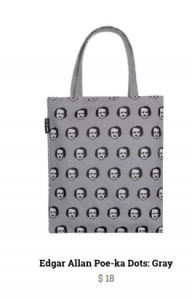 From Kate Flora: We’re running another giveaway for the month of May, the winner to be chosen from those who comment on May posts here at Maine Crime Writers. The prize is a Poe tote bag containing books by some of our regular bloggers. All you have to do to enter is post a comment on any blog appearing in May. The April prize, a Nancy Drew tote bag with goodies and books, was won by “Gram.” Runner up was “Skye,” who won a jar of Stonewall Kitchen blueberry jam.
From Kate Flora: We’re running another giveaway for the month of May, the winner to be chosen from those who comment on May posts here at Maine Crime Writers. The prize is a Poe tote bag containing books by some of our regular bloggers. All you have to do to enter is post a comment on any blog appearing in May. The April prize, a Nancy Drew tote bag with goodies and books, was won by “Gram.” Runner up was “Skye,” who won a jar of Stonewall Kitchen blueberry jam.
In other news, bestselling mystery writer Nevada Barr has set her newest Anna Pigeon novel, Boar Island, in Acadia National Park. Want to meet her? She will be making two appearances at Maine libraries. On Monday, May 23 at 6:30 PM she will be at Jesup Memorial Library in Bar Harbor and on Tuesday, May 24 at 6:30 PM she will be the guest of Gray Public Library in Gray, Maine. The Gray event will be held at the Spring Meadow Golf Club. Tickets are free, but must be acquired in advance. For more information, call 657-4110.
Vaughn C. Hardacker’s novel, THE FISHERMAN, was selected as a finalist in the Crime Fiction Category of the 2016 Maine Literary Awards by the Maine Writers & Publishers Alliance. The winners will be announced at the SPACE Gallery in Portland on May 26, 2016.
Maureen Milliken is traveling south of the border to participate in the Local Authors 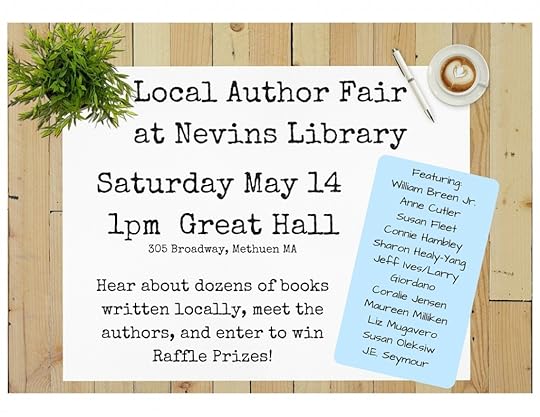 Fair at the Nevins Library in Methuen, Mass. The event is from 1-3 p.m. and there are a lot of cool authors to meet and get books signed by.
Fair at the Nevins Library in Methuen, Mass. The event is from 1-3 p.m. and there are a lot of cool authors to meet and get books signed by.
While Maureen isn’t a “local author” currently, she spent some of her formative newspaper reporter years in nearby Haverhill, where she worked at the Haverhill Gazette.
Please stop by and say hit to Maureen and the other authors!
An invitation to readers of this blog: Do you have news relating to Maine, Crime, or Writing? We’d love to hear from you. Just comment below to share.
And a reminder: If your library, school, or organization is looking for a speaker, we are often available to talk about the writing process, research, where we get our ideas, and other mysteries of the business. Contact Kate Flora: mailto: kateflora@gmail.com
May 12, 2016
It’s Friday the 13th, and We’re Asking: What Scares You?
Maine Crime Writers here, celebrating Friday the 13th by sharing stories of the books, movies, and real life events that have scared us. It may not always be true, but one of the benefits of being a crime writer is that anything can be grist for the mill. It lets us turn life’s big scares into emotions we can tap for the page. So here, without further ado, our stories:
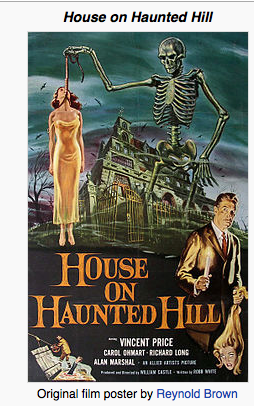 Kate Flora: Back when I was a kid, and going to the movies was a rare thing that involved driving all the way to Rockland, my brother got the bee in his bonnet that we should all go to see a movie called The House on Haunted Hill. Somehow, I was convinced that it would be funny. To find the money for tickets, we scoured old purses, went through coat pockets and even vacuumed registers to find lost coins. Then, money in hand, we went to the movies. It was NOT a funny movie. It was a terrifying movie. One of those Ten Little Indians sorts of films where everyone got killed off. I had nightmares for years and having entirely forgiven my brother John for suggesting it.
Kate Flora: Back when I was a kid, and going to the movies was a rare thing that involved driving all the way to Rockland, my brother got the bee in his bonnet that we should all go to see a movie called The House on Haunted Hill. Somehow, I was convinced that it would be funny. To find the money for tickets, we scoured old purses, went through coat pockets and even vacuumed registers to find lost coins. Then, money in hand, we went to the movies. It was NOT a funny movie. It was a terrifying movie. One of those Ten Little Indians sorts of films where everyone got killed off. I had nightmares for years and having entirely forgiven my brother John for suggesting it.
From Wikipedia: House on Haunted Hill is a 1959 American horror film. It was directed by William Castle, written by Robb White and stars Vincent Price as eccentric millionaire Frederick Loren. He and his fourth wife, Annabelle, have invited five people to the house for a “haunted house” party. Whoever stays in the house for one night will earn $10,000. As the night progresses, all the guests are trapped inside the house with ghosts, murderers, and other terrors.
Kaitlyn Dunnett/Kathy Lynn Emerson: The scariest movie from my childhood? The Seventh Voyage of Sinbad! I spent weeks looking over my shoulder, expecting to find the Cyclops behind me. They used pretty hokey special effects by today’s standards, but back then? Terrifying!
Maureen Milliken: When I was a preteen, my brother, sister and I took turns reading The Mystery of the Crimson Ghost by Phyllis A. Whitney to each other (was that weird, that we used sit around reading to each other? I don’t know). I don’t remember much about the book, except that there was a giant ghost dog that glowed crimson and it scared the hell out of me. I know there was a logical explanation for it at the end, but that image is the one thing I can remember — the unknown, unexplained and terrifying.
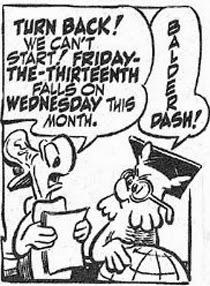 By the way, here’s a thought about Friday the 13th and writing: I don’t think one month has gone by since those young years that on the 13th of the month I haven’t thought of Pogo, my all-time favorite comic strip. On the 13th of the month, if it wasn’t a Friday, one of us kids would say “Friday the 13th comes on a (whatever the day is) this month.” I’m not superstitious at all, but that resonates with me, the idea that a small, innocuous thing can trigger such big feelings in people. It also always makes me think of the other great line from Pogo, “We have met the enemy and he is us.” As a writer, I’m constantly absorbing impressions — seriously, I didn’t pick this, it picked me — and the things that trigger feelings in people, whether it’s Friday the 13th, Pogo, a crimson dog ghost tend to form the bigger ideas that end up being the foundation of books.
By the way, here’s a thought about Friday the 13th and writing: I don’t think one month has gone by since those young years that on the 13th of the month I haven’t thought of Pogo, my all-time favorite comic strip. On the 13th of the month, if it wasn’t a Friday, one of us kids would say “Friday the 13th comes on a (whatever the day is) this month.” I’m not superstitious at all, but that resonates with me, the idea that a small, innocuous thing can trigger such big feelings in people. It also always makes me think of the other great line from Pogo, “We have met the enemy and he is us.” As a writer, I’m constantly absorbing impressions — seriously, I didn’t pick this, it picked me — and the things that trigger feelings in people, whether it’s Friday the 13th, Pogo, a crimson dog ghost tend to form the bigger ideas that end up being the foundation of books.
I’ve realized that all the “big” things in my books — tone, voice, character — all come from these little snapshots in my head, many of which I’ve had for decades. Sorry if that’s all new-agey and navel-gazey, but I’ve got the third book forming (with number four elbowing in) and the process is all-consuming. In fact, it reminds me of another quote from Pogo: “We are confronted with insurmountable opportunities.”
Bruce Robert Coffin: When I was twelve-years-old I read my first Stephen King novel, Salem’s Lot. Having been a fan of the supernatural genre, this was not my first foray into the world of literary macabre. It was however my first “adult” horror novel, as my prior reading was mainly limited to what readers of today might call young adult (YA) novels. I still remember the scary Bookland television commercial for the King novel, which usually ran just after dinner each night.
The story about a writer who revisits his boyhood home of Jerusalem’s Lot, Maine is filled with creepy characters, a haunted house, and vanishing townsfolk. If you like horror stories, this book is a must read. But be forewarned, lock all of your doors…
Chris Holm: Hmm. What to talk about? My first brush with grown-up horror? (Like Bruce’s, it was a Stephen King novel.) My all-time favorite horror movie? (John Carpenter’s The Thing, which may be my favorite movie period.) The time, when I was little, that I woke up to find myself covered in insects? (Yup, that actually happened. It inspired a lifelong phobia and a creepy scene in The Wrong Goodbye.)
Nah. Instead, I’ll highlight something new that scared the heck out of me: the indie horror movie Hush. It’s a gorgeously acted and directed movie about a deaf woman (and thriller writer!) who winds up terrorized by a would-be home invader. (Spoiler: she proves more resourceful than he bargained for.) Made on a shoestring by a husband and wife team (they co-wrote; she stars; he directs), it’s smart, scary, and satisfying from start to finish. It’s also streaming now on Netflix.
Brenda Buchanan: I read Helter Skelter the first winter I lived in Maine. I was living in a cottage that creaked and groaned when the wind howled across the adjacent marsh. I started Vincent Bugliosi’s account of the investigation and trial of Charles Manson and his gang on the Friday of a long weekend when my housemate had gone off to Boston. Once I started reading I could not stop, even though it meant I slept with every light in the house blazing all three nights. I’m not one bit ashamed to admit it, either.
Jessie Crockett: When I was about 10 I read And Then There Were None by Agatha Christie. I had started it in the afternoon and couldn’t put it down. After I was supposed to be in bed that night I read it under the covers. Between the setting, the creepy use of a nusery rhyme and worrying about being caught for staying up past bedtime I was terrified. But I couldn’t stop reading. I guess that is why Christie is still a bestseller!
Barb Ross: When I was five or so, we had an older woman who babysat for us. A night owl even then, I’d go to bed and stay awake as long as I could, then wander back to the living room rubbing my eyes and whining, “I can’t sleep.” Once when I did that she was watching an episode of Perry Mason. It was about a little girl who comes to Perry’s office and says, “I want you to find out who I am.” Of course, he takes the case. She gets dolls at regular intervals from Switzerland, so Perry goes there to investigate. At the halfway point, a doll arrives at Perry’s hotel room with it’s neck broken clean in half and a note that says, “This can happen to little girls, too.” And then the stupid woman sent me to bed!! I never saw the resolution. I was terrified by this for years.
Readers, what scares you?
May 11, 2016
The Devil’s On His Way
Friday the 13th is nearly upon us. We’ve got a special group post lined up for tomorrow to celebrate, but — as a writer with a(n un)healthy fondness for the macabre — I thought I’d take the opportunity to talk a bit about superstition.
Though my work often dabbles in the supernatural, I’m something of a skeptic in real life. That’s what I tell myself, at least. But if you were to watch a Pats game with me, you’d come away with another impression entirely. If my cat’s on my lap when we find the endzone, she’s not allowed to leave. If we fumble while I’m drinking my beer, the remainder of it will sit untouched. And on the rare occasion the announcers deign to compliment our play, I knock wood in an effort to undo the jinx.
Do I really believe I’m impacting the game in any way? Nah. (Half the time, I’m not even watching live.) But on the other hand, why chance it?
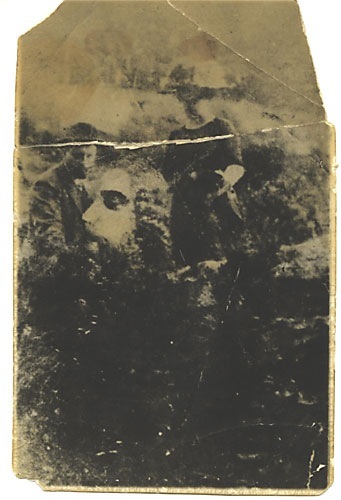
Baby or savior? OR BABY SAVIOR?
The fact is, superstition’s baked into our DNA. Our brains are designed to recognize patterns, and evolution has selected for a hair trigger. If a warm wind’s blowing from the east and every animal in the forest is headed west, the caveman who fails to recognize a fire’s coming doesn’t last long enough to pass along his (blissfully carefree) genes. Wash, rinse, repeat… and a few thousand generations later, we’re seeing Jesus in old pictures and blaming bad days on the movements of the planets.
While I enjoy recreationally indulging my superstitious side*, I try not to let it alter my behavior in real life. I cultivate good writing habits, but push back whenever I sense they’re ossifying into rituals. I don’t buy into lucky hats or socks or pens or chairs, and I sure as hell don’t wait around for my muse. Writing isn’t magic. It isn’t luck. It’s work. (Fun work, but work nonetheless.) So, at every turn, I endeavor to treat it as such.
Although, okay, I’ll confess: if my prior day’s writing was like pulling teeth, I’ll usually swap out my coffee mug. That’s not superstition, though; it’s psychology. I’m making a symbolic change to my environment to signal to my subconscious that OH, WHO AM I KIDDING? OF COURSE IT’S SUPERSTITION.
So… where do you fall on the spectrum? Are you a believer or a skeptic? What silly writing rituals do you adhere to? IRRATIONAL MINDS WANT TO KNOW!
*If you’re fond of recreationally indulging your superstitious side, too, allow me to point you toward two of my current obsessions: TANIS and The Black Tapes. Both are podcasts produced by Pacific Northwest Stories. Both are free to download on iTunes. Both are works of fiction, although they work hard to sound as if they’re nonfiction (and do a remarkable job at it, too). The Black Tapes is best described as Serial meets The X-Files. TANIS is a little harder to pin down. But if, like me, you’re a fan of the creepy, the supernatural, the unexplained, give the first episode of each a try. (I listen while I run, but I’m told they’re also great for commutes.) My guess is, you’ll wind up hooked.
Lea Wait's Blog
- Lea Wait's profile
- 509 followers


